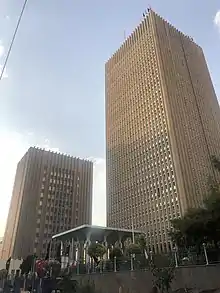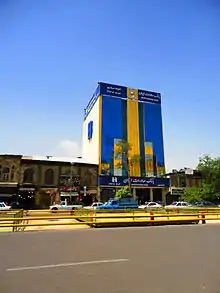Bank Saderat Iran
Bank Saderat Iran (BSI) (Persian: بانک صادرات ایران, Bank Sadârat Iran, lit. "Export Bank of Iran") is an Iranian multinational banking and financial services company headquartered in Tehran, Iran. It is Iran's largest bank. It was founded in Tehran in 1952 by the prominent Mofarrah and Bolurfrushan (also spelled Bolourforoushan) families, represented in the first board by Mohammad Ali Mofarrah and Mohammad Bolurfrushan[3] and commenced operation on 13 November 1952 with a board of three directors and 20 employees.
 | |
 | |
| Type | State-Owned |
|---|---|
| Industry | Banking, Financial services |
| Founded | 1952, Tehran |
| Founder | Mohammad Ali Mofarrah |
| Headquarters | Bank Saderat Tower, 43 Somayeh Avenue, Tehran, Iran |
Area served | Worldwide |
Key people | Zia Imani (CEO) |
| Services | Credit cards, consumer banking, corporate banking, investment banking, mortgage loans, private banking, wealth management |
| Revenue | |
| Total assets | |
| Total equity | |
Number of employees | 24,369 (2021) [2] |
| Subsidiaries | Bank Saderat PLC (London), Bank Saderat Tashkent. |
| Website | www |


Bank Saderat Iran has around 3,500 offices in 12 countries and territories across Europe, the Middle East and Asia, and around 10 million customers. As of 30 June 2013, it had total assets of $59.110 billion. BSI has 28 international branches and services in 12 countries.
History
On 7 June 1979, after the Iranian Revolution, all Iranian private banks were nationalized, quite to the dismay of the founding families, and became state-owned. In 1980, branches and sub-branches of BSI in the Iranian provinces were turned into independent banks, named Bank Saderat Ostan (province). Today, BSI has 29 owned provincial bank subsidiaries and over 200 affiliated companies, supervised by Ghadir Investment Company. Iranian banks are administered on the basis of a law passed by the Islamic Revolution Council on 25 September 1979, and the provisions of its Articles of Association.
Bank Saderat is used by the Government of Iran to transfer money to what the U.S.-designated terrorist organizations, including Hezbollah, Hamas, the Popular Front for the Liberation of Palestine-General Command and Palestinian Islamic Jihad, as alleged by U.S. Department of the Treasury.[4][5]
Under the current Iranian Transactions Regulations (31 CFR Part 560), U.S. banks may process certain funds transfers involving an Iranian bank, such as transfers for authorized or exempt transactions and "U-turn" transactions. U-turn transactions allow U.S. banks to process payments involving Iran that begin and end with a non-Iranian foreign bank. Bank Saderat will not be able to participate in any transfers involving U.S. banks, effective from the date that the amendment to the regulations is filed with the U.S. Federal Register. By prohibiting U-turn and all other transactions with Bank Saderat, the bank is denied all direct and indirect access to the U.S. financial system.[6]
Bank Saderat Iran currently conducts banking in the UAE, handling Iranian trade in and out of Dubai. Bank Saderat's profits are the third highest among foreign banks within UAE. The bank mainly deals in project financing, letters of credit and bank guarantees (demand guarantees), whereas other activities remains less important.
In February 2013, the European General Court in Luxembourg ruled to annul sanctions by the European Union (EU) against the bank, stating that the EU "is in breach of the obligation to state reasons and the obligation to disclose to the applicant ... the evidence adduced against it". The EU may appeal the decision.[7] As of 2016, the EU asset freeze was still in effect.[8]
In 2019 an EU court rejected BSI's appeal for £78.7m in damages the bank claims to have suffered after the EU placed it on their sanctions list.[9]
Location of branches
- United Arab Emirates (Abu Dhabi - 3 branches and Dubai - 6 branches)
- Lebanon (Beirut - 4 branches, Sidon and Baalbek)
- Afghanistan (Kabul - 2 branches)
- Qatar (Doha - 2 branches)
- Bahrain (Manama)
- France (Paris)
- Germany (Hamburg and Frankfurt)
- Italy (Venice)
- Pakistan (Karachi)
- Oman (Muscat)
- Turkmenistan (Ashkhabad)
- United Kingdom (London)
- Uzbekistan (Tashkent)
See also
References
- "Annual Report 2013". Bank Saderat Iran. Retrieved 20 March 2013.
- "Annual Report 2021". Bank Saderat Iran. Archived from the original on 2 August 2021. Retrieved 20 March 2021.
- "بانک صادرات ایران - تاریخچه". Archived from the original on 18 September 2018. Retrieved 13 December 2016.
- "Fact Sheet: Designation of Iranian Entities and Individuals for Proliferation Activities and Support for Terrorism".
- "Hezbollah Finances: Funding the Party of God". The Washington Institute.
- "UPDATE 1-US Treasury tightens banking sanctions on Iran". Reuters. 6 November 2008.
- "EU court rules for second time against Iran bank sanctions". Reuters. 6 February 2013. Retrieved 16 April 2013.
- "European Union and United Kingdom Sanctions Update: March 2016". K&L Gates. 17 March 2016. Retrieved 21 May 2016.
- "Iranian bank loses bid for £78.7m in damages from the EU over sanctions error". 6 June 2019.